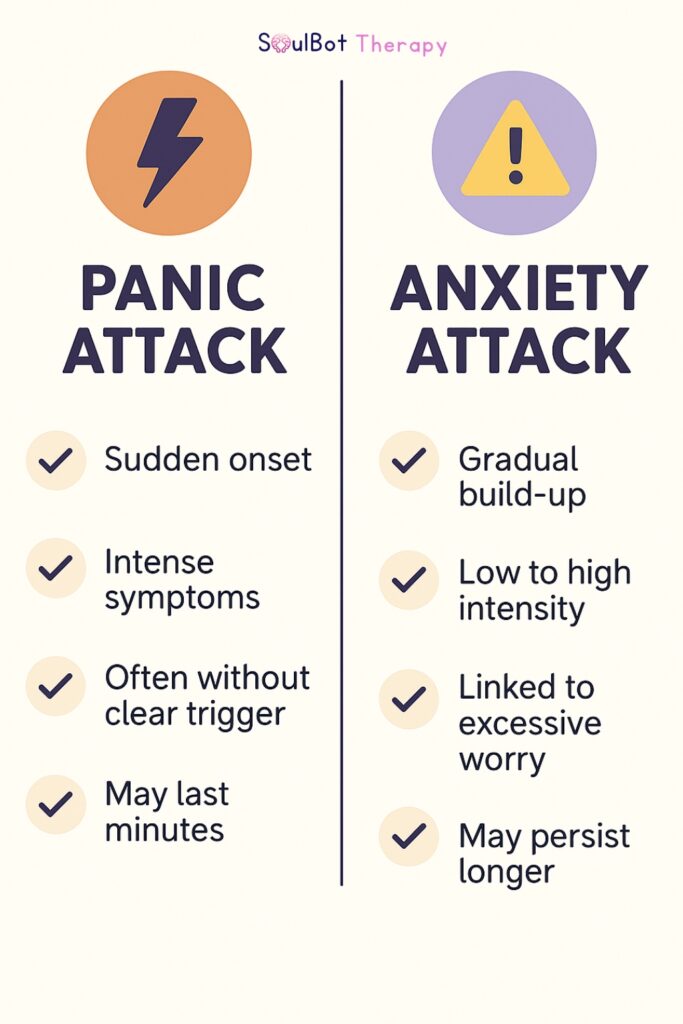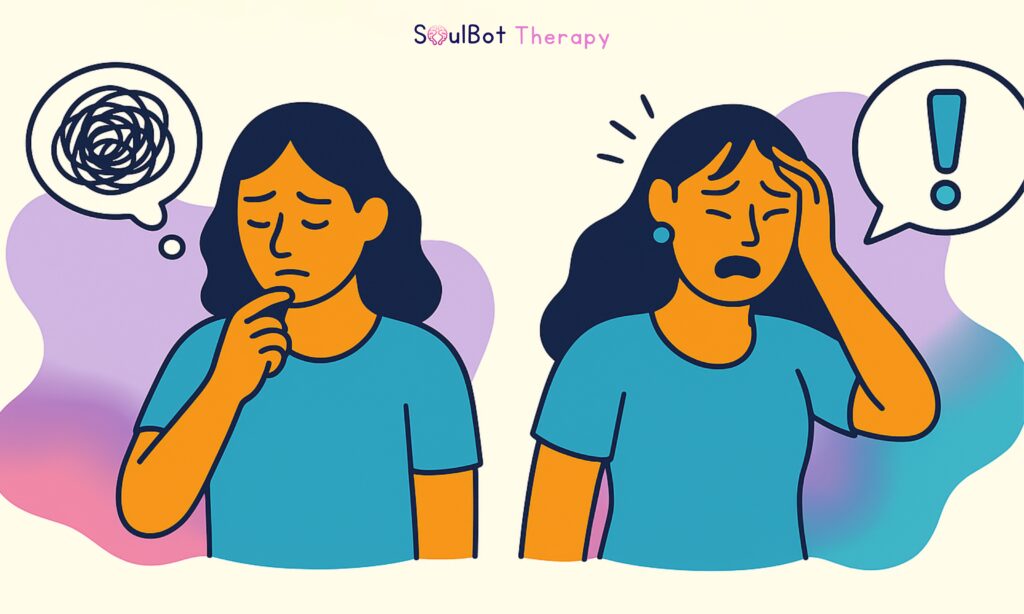Let’s clear something up right away: panic attack vs anxiety attack isn’t just a vocabulary mix-up, it’s a clinical difference. People throw these terms around like they’re interchangeable, but if you’ve lived through either, you know they don’t feel the same. And getting it right matters. Understanding the difference between anxiety and panic attacks can change how you cope, heal, and get support.
Here’s how both conditions show up, what separates them, and how to manage them with clarity, not fear.
What Is the Difference Between Panic Attack and Anxiety Attack?
Let’s break it down, panic attack vs anxiety attack:
An anxiety attack isn’t a medical diagnosis. It’s more of a label we use for moments of extreme worry or fear. These episodes build gradually, usually tied to real stressors like an upcoming exam, a breakup, or a health scare.
A panic attack, on the other hand, shows up out of nowhere. It peaks fast, hits hard, and comes with alarming physical symptoms. According to the DSM-5, a panic attack includes at least four of the following:
- Racing heartbeat
- Shortness of breath
- Chest pain
- Sweating or chills
- Dizziness or nausea
- Feeling like you’re dying or losing control
🧠 Struggling with connection during anxious episodes?
Take the Love Language Test to understand how you give and accept emotional support, which helps you communicate better during distress.
GAD vs Panic Disorder: What’s Actually Going On?
If you’ve ever typed generalised anxiety disorder vs panic disorder into Google at 2 AM, here’s the answer:
- Generalised Anxiety Disorder (GAD) feels like a background hum of worry always there, even when life is calm.
- Panic Disorder is about sudden, repeated panic attacks that seem to come out of nowhere.
You can have both. Many people with chronic anxiety also experience panic attacks. But the anxiety vs panic disorder symptoms are distinct and need different strategies.
🧠SoulFact: According to Harvard Medical School, panic attacks activate the brain's fear center (the amygdala) more intensely than generalized anxiety, which involves prolonged stress circuits like the hippocampus and prefrontal cortex.
Symptoms Breakdown: Panic Attack vs Anxiety Attack
| Symptom | Anxiety Attack | Panic Attack |
|---|---|---|
| Onset | Gradual | Sudden |
| Duration | Can last hours or days | Usually peaks in 10 minutes |
| Triggers | Situational, ongoing stress | Sometimes no clear trigger |
| Physical Sensations | Tense, restless, uneasy | Heart racing, breathlessness |
| Mental State | Worrying thoughts, overthinking | Terror, feeling out of control |
| Response to Reassurance | Some relief possible | Often feels helpless or urgent |
Knowing the difference between anxiety and panic attacks helps tailor your coping strategies and treatment plans.

Anxiety is like having a browser with 47 tabs open. 3 are frozen, and you have no idea where the music is coming from
Real-Life Scenario: Chronic Anxiety vs Panic Attacks
Imagine you’ve been anxious for months, can’t sleep, and constantly feel tense. That’s likely GAD.
Now picture this: You’re grocery shopping when suddenly your chest tightens, your vision blurs, and you’re sure you’re dying. That’s a panic attack. And while both are rooted in anxiety, they manifest very differently.
What Triggers Panic Attack vs Anxiety Attack?
Stress, deadlines, fights, and bills typically trigger anxiety attacks. You feel it building.
Panic attacks? Sometimes there’s no trigger at all. They can crash into you mid-conversation, during lunch, or right after waking up. That unpredictability makes them terrifying.
📊SoulFact: As per the NIMH, panic disorder affects about 2–3% of adults in the U.S. each year, while generalized anxiety disorder impacts over 6.8 million adults, showing how both panic attack vs anxiety attack conditions are common yet uniquely disruptive.
When It’s Time to Get Help
If you’re constantly wondering “Is this a panic attack or an anxiety disorder?” that’s your sign to stop guessing. Talk to a professional.
🔹Cognitive Behavioural Therapy (CBT) is effective for both.
🔹Mindfulness and breathwork help regulate fear responses.
🔹Medication may be necessary for more intense cases.
🔹AI tools like SoulBot give you judgment-free support with check-ins and personalised prompts.
Final Thought
There’s no award for tolerating pain in silence. Whether it’s lingering dread or sudden panic, both are valid. And both are treatable. The more you understand about panic attack vs anxiety attack, the better equipped you’ll be to regain balance.
“You don’t have to control your thoughts. You just have to stop letting them control you.”
Dan Millman
🧘Let SoulBot walk that road with you.








